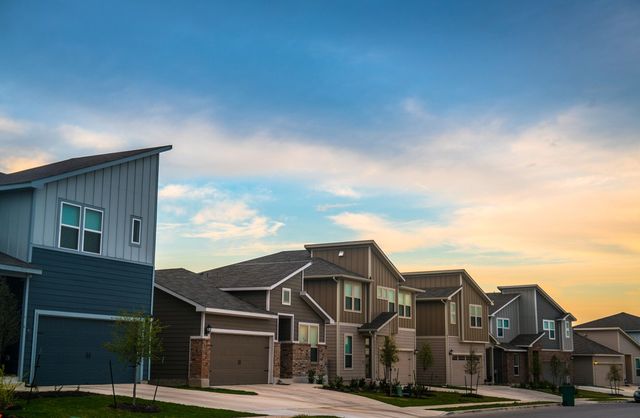
Tony Frenzel for realtor.com
In just four weeks, voters from all corners of this bitterly divided country will cast their votes for the man who will either become or remain America’s next president. Pollsters, pundits, and politicos have obsessed over the ever-shifting electoral map and how a handful of swing counties and states could decide whether President Donald Trump or former Vice President Joe Biden will be named the nation’s commander in chief in what is shaping up to be the most contentious election ever.
There’s a head-spinning number of variables at play: the continuing coronavirus crisis, a struggling economy, a reckoning on systemic racial issues and police violence, increasing crime in big cities, and, most recently, the pitched fight over replacing Ruth Bader Ginsburg on the Supreme Court.
However, the race could come down to the demographic shifts of where people live—and the proportion of blue states vs. red states. And that, according to a recent realtor.com® analysis, appears to be going through a major change.
Since the last election in 2016, the lack of housing affordability has forced more folks priced out of the ultraexpensive blue cities into cheaper red ones, turning these areas shades of purple: true swing states. And COVID-19 is helping to accelerate shifts from city areas to suburban battlegrounds.
That’s why four swing states that Trump won in 2016 have the potential to flip in the former vice president’s favor in this election, according to our analysis, based on search activity on realtor.com home listings.
Pennsylvania, Wisconsin, Florida, and Michigan could tip into Biden territory if home buyers from blue counties looking at homes in red counties went through with their purchases. With these razor-thin margins, that could be just enough to swing the election—or not, if home searchers decide to put off their buying decisions.
“This movement could be enough to mean states that went for Trump in 2016 may go for Biden in 2020,” says realtor.com Chief Economist Danielle Hale. “If people take their political beliefs with them, that could lead to a changing electoral map.”

Justin Merriman/Bloomberg via Getty Images
Only one of 30 confirmed red states, Georgia, is not expected to be more blue in this election.That’s due to folks from liberal strongholds such as New York and California, as well as more local, progressive cities, relocating to these more conservative parts of the country that boast lower costs of living.
Eight blue states plus Washington, DC, are expected to trend more red this year. However, none is expected to tip for Trump.
“COVID[-19] helped exacerbate some trends that were happening before,” says Jonathan Bydlak, interim director of the governance program at the R Street Institution, a think tank. “There’s no doubt people are moving out of some of these higher-tax states, like California and New York, [and into states] where homes are more affordable, taxes are lower, and jobs more plentiful. That obviously has electoral complications.”
To come up with these findings, realtor.com looked where home shoppers were based and the counties where they were searching for real estate online from August 2017 through August 2020. Our analysts looked at the percentage of the population in each county that voted Republican and Democratic in the 2016 presidential election. They then assumed that same percentage of home shoppers would bring those political affiliations to the counties where they were seeking to buy homes.
That additional percentage was used to determine if a state would remain Republican or Democratic—or flip.
The states that could flip from red to blue in 2020
All eyes are on the swing states this year, particularly Florida, the biggest electoral prize among them.
Florida voters elected Trump in 2016 by just 1.2% of the vote margin. This year, Biden may have a better shot of winning over Sunshine State voters. Four of the five states that buyers were browsing Florida real estate from were based out of solidly blue territory: New York, New Jersey, Illinois, and California, according to the realtor.com analysis.

EVA MARIE UZCATEGUI/AFP via Getty Images
Buyers from the red state of Georgia also looked at Florida homes online. But they hailed from blue counties within Georgia.
“People are indeed leaving expensive coastal areas and are going to areas where generally homes are more affordable,” says Hale. The median home list price was $345,050 in Florida—compared with $550,050 in New York and $698,550 in California, according to August realtor.com data.
Many of these peripatetic folks were retirees; about 587,700 people aged 60 or older moved to Florida in 2018, according to the latest U.S. Census Bureau data. And while baby boomers are more likely to identify as Republicans than, say, millennials, many of these retirees are coming from fiercely left-leaning states.
If they go ahead and move to Florida, it could shift the state 0.7% to the left. With an additional 0.9% of Florida residents looking at out-of-state real estate, that shift could be just enough to barely swing this crucial state.
Other coin-toss states that have traditionally swung Democratic in recent years could see similar shifts. Michigan could pick up a 0.4% increase in Democrats while losing the same percentage of Republicans, according to the realtor.com analysis; Pennsylvania and Wisconsin could experience a 0.6% and 0.8% boost in Democrats, respectively. Trump won those states by margins of 0.2% of a percentage point in Michigan and 0.7% in Pennsylvania and Wisconsin.
“Trump won by a very small margin. They were part of what used to be called the Blue Wall in the Midwest,” says demographer William Frey, of the Brookings Institution, a Washington, DC–based think tank. So it wouldn’t take much to flip them back.

RoschetzkyIstockPhoto/iStock
Many younger professionals are choosing more affordable cities where they can find good jobs. Burgeoning tech hubs in places like Austin, TX; Salt Lake City; Raleigh, NC; and Denver have siphoned workers out of Silicon Valley with its mind-bogglingly high price tags. (The median home list price in Silicon Valley’s San Jose, CA, was $1.2 million compared with $392,300 in Austin.) And many are bringing their political affiliations with them.
That could have a significant impact on future elections when states like Texas, North Carolina, Georgia, and Arizona could play a bigger role. These traditionally more conservative states have become more liberal in recent years as they’ve attracted more millennials, a more progressive, racially diverse generation, and those leaving more expensive blue states behind.
Could the pandemic swing the election?
Many are predicting that the continuing exodus from the big cities and into the suburbs, exacerbated by the pandemic, could cause political ripples. But it’s too early to tell how pervasive this deurbanization trend really is—and how much impact it will have on the nation’s political breakdown.
“The big question is where are the New York City and San Francisco refugees going,” wonders Stanford University political science professor Jonathan Rodden, author of “Why Cities Lose: The Deep Roots of the Urban-Rural Political Divide.” “If they are moving to suburbs or other parts of New York state or California … this will have no impact on the Electoral College.”
But if, say, the New Yorkers are heading to Pennsylvania or the San Franciscans are moving to the swing state of Arizona, that could be a much bigger deal.

3dan3/iStock
“We don’t know how much of this is actually happening,” Ashley Koning, director of the Eagleton Center for Public Interest Polling at Rutgers University, says of the urban to suburban shift. “We know home sales in the suburbs are up. But in battleground states, this movement would have to be a critical mass to sway election results.”
The latest political battleground: The suburbs
“The suburban voting block has become so incredibly important in this election cycle,” says Koning. “White suburban votes in past election cycles have [typically] gone for the Republican candidates. [But] suburban voters are becoming somewhat of a swing voter.”

visualspace/Getty Images
Suburban women, in particular, could help determine the election. And the suburbs are becoming more racially diverse: Minorities represented more than a third of suburban residents in the 2000s, according to the Brookings Institution. Those who fled the cities for the suburbs during the pandemic could also signal a change—if they registered to vote in time in their communities.
How these voters perceive the candidates, not just party loyalty, could help shift the electoral map. For example, Trump’s policies appealed to many former Democrats in the Rust Belt in 2016, which may have helped him to win the election.
“It’s not that Biden is winning the suburbs,” says Bydlak. “It’s that many people who live in the suburbs may be turned off by certain policies of the president.”
The post Americans Are Moving in Droves: Will It Totally Remake the Electoral Map? appeared first on Real Estate News & Insights | realtor.com®.
